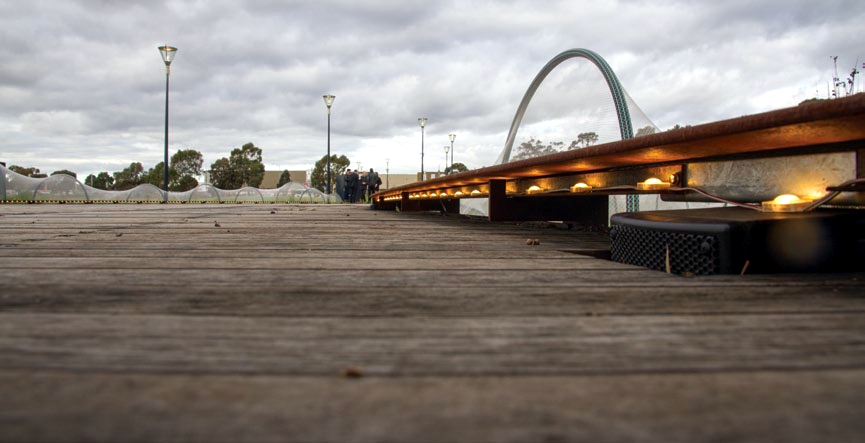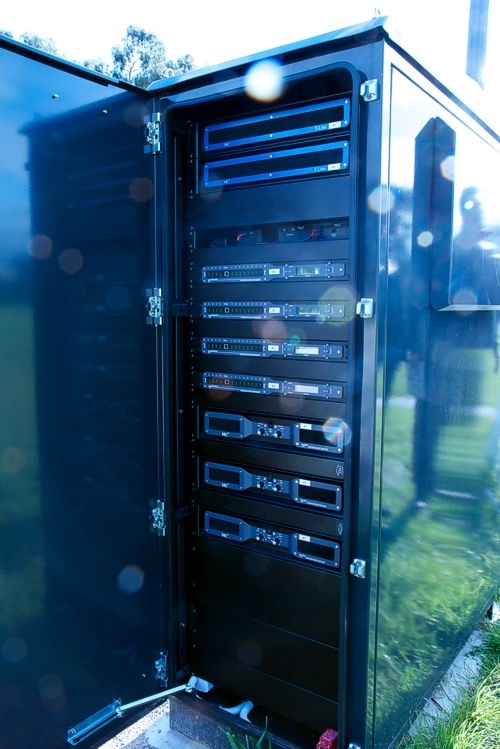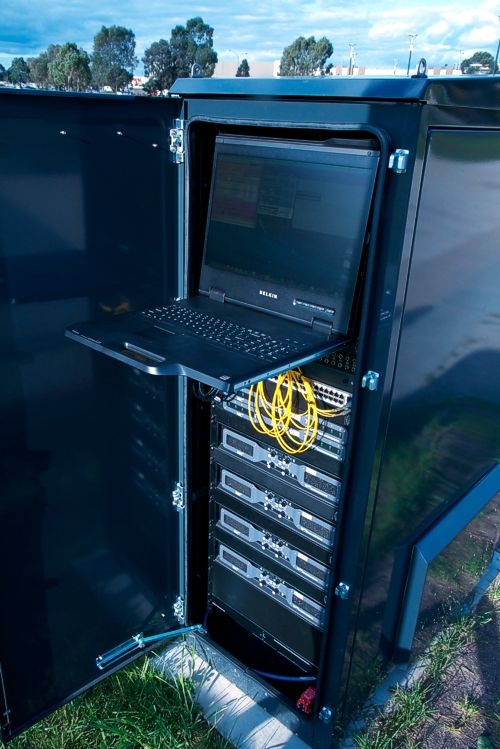
The Royal Melbourne Institute of Technology spans several campuses within the Melbourne area, as well as having worldwide connections with research centres and other universities, with emphasis on technology, design and computing. The Bundoora campus based just outside the city is attended by thousands of students every day, with bioscience, pharmacy, and Chinese medicine being the focus. Being close enough to the city centre, the campus doesn’t have any on site accomodation for sutdents so they travel in en masse every day, and the vast majority of them do so crossing a thoroughly modern footbridge from the public transport hub to the main site.
And now, this same footbridge boasts a permanent sound art installation, designed to be fully remotely monitored and controlled, and be completely adaptable, both in terms of playback content and configuration. This aspect of the design was part of the original brief, so that the “sound canvas” would be available to post-grad students as well as for use with bought-in or specially commissioned soundscapes.
 Dr Lawrence Harvey, is an RMIT Associate Professor and curator of the sound art collection. Along with RMIT Gallery Director Suzanne Davies and Collections Coordinator, Jon Buckingham, it was his energy and experience that convinced the RMIT Art Committee to bankroll the collection, which eventually led to the system. But first he looked at what was right and wrong with other public spaces that have been wired for sound: “We did a study on sound scale installations around the city. It became obvious that these installs quickly became a passive piece of hardware. There was no sense of there being a curatorial imension or collection policy. Which is what we took up with RMIT Gallery. The partnership with RMIT is perfect because they’re more interested in maintaining an installation, given the institution’s remit is to push the research and experimental aspects of the work. “Around that time I was involved in setting up a sound art exhibition called Sound Bites City. That formed the nucleus of the collection we have for the RMIT system. We’re planning to commission further pieces especially for this installation.”
Dr Lawrence Harvey, is an RMIT Associate Professor and curator of the sound art collection. Along with RMIT Gallery Director Suzanne Davies and Collections Coordinator, Jon Buckingham, it was his energy and experience that convinced the RMIT Art Committee to bankroll the collection, which eventually led to the system. But first he looked at what was right and wrong with other public spaces that have been wired for sound: “We did a study on sound scale installations around the city. It became obvious that these installs quickly became a passive piece of hardware. There was no sense of there being a curatorial imension or collection policy. Which is what we took up with RMIT Gallery. The partnership with RMIT is perfect because they’re more interested in maintaining an installation, given the institution’s remit is to push the research and experimental aspects of the work. “Around that time I was involved in setting up a sound art exhibition called Sound Bites City. That formed the nucleus of the collection we have for the RMIT system. We’re planning to commission further pieces especially for this installation.”
The audio delivery might be via a battery of compact One Systems loudspeakers neatly installed along the bridge, chosen for their excellent weather resistance. But the real action is in the double-sided AV rack, which sits rather incongruously on location, like a hi-tech monolith accidentally parachuted onto a Wind in the Willows set. The 19 audio works are stored on an Apple Mac Mini. Each day a new playlist is generated. The pieces are played from a digital audio software called Reaper, chosen for its ability to reliably run multichannel audio. (Each piece may run in anything from two-channel stereo through to 16 or more channels.)
MC2’s Australian distributor, CMI, supplied all the amplification, processing and breakout boxes, as well as the speaker systems for a complete solution.
System Designer Simon Tait talks us through the install: This system design addressed the problems installation like this have had in the past: namely, they’ve been impossible to patch into and control/monitor, resulting in reduced flexibility. Audio from the Mac Mini running Reaper goes into a Dante virtual sound card and is broken out into the analogue domain via two eight-channel MC2 Dante breakout boxes.
The analogue audio passes through a half-normalled TRS patchbay. So effectively it acts as a piece of wire until someone wants to patch into the system, whereupon it’ll bypass Reaper and the Dante box.
Before reaching the amp, the audio passes through the XTA DC1048 processors for speaker management processing. Importantly the DC1048s will limit any signal coming in that’s too hot (protecting the loudspeakers) and it performs some system EQ. It also acts as a crossover to send audio to the subs.
There are 22 amplifier channels. Each channel runs into a MC2 100V line impedance transformer. MC2 doesn’t make off-the-peg 100V line amps but its impedance transformers perform exceptionally well. The MC2 amps are networked using an RS485 data bus. It allows RMIT’s city campus to manually tinker with the playlist — add or delete tracks. The amps also have GPIO inputs. A Command Fusion brain triggers the switch at 10pm to power down the amps and will switch them on again in the morning. There’s also a thermostat inside the rack which will shut down the whole rack if the internal temperature exceeds 65°C. It’ll wait until the morning to power up again.”
 A matrixing plug-in called Reasurround allows the multichannel audio to be easily and graphically mapped to the 16 destination loudspeakers. Bear in mind, many of the pieces were devised for very specific gallery installations (a cube, or two concentric rings of speakers, for example), so the work often needs to be reconfigured for the bridge. The audio is output from the Mac Mini via a Dante card into XTA DC1048 processors and then into MC2 Ti4250 four-channel power amplifiers (via MC2 Dante eight-way breakout boxes). The 16 channels of audio are then routed through line impedance matching transformers for 100V transmission to the One Systems 103IM loudspeakers. Another six One Systems 208CIM double-eight-inch subs are each driven off one side of a MC2 Ti1500 power amp.
A matrixing plug-in called Reasurround allows the multichannel audio to be easily and graphically mapped to the 16 destination loudspeakers. Bear in mind, many of the pieces were devised for very specific gallery installations (a cube, or two concentric rings of speakers, for example), so the work often needs to be reconfigured for the bridge. The audio is output from the Mac Mini via a Dante card into XTA DC1048 processors and then into MC2 Ti4250 four-channel power amplifiers (via MC2 Dante eight-way breakout boxes). The 16 channels of audio are then routed through line impedance matching transformers for 100V transmission to the One Systems 103IM loudspeakers. Another six One Systems 208CIM double-eight-inch subs are each driven off one side of a MC2 Ti1500 power amp.
Each loudspeaker is discretely concealed in and under the edge of the bridge. The subs are mounted underneath, pointed downwards. Everything about the job looks to be expertly installed and remarkably well spec’ed. Certainly the results are excellent. But what measure of success do you place on a system such as this? There was talk in the group that perambulating Bundoora RMIT students may have a lower iPod/headphone quotient than their CBD counterparts, and perhaps the sound art could well be contributing to that. More realistically, the students and staff happily accept the bridge, with its experimental groanings, horror movie rattles, wraparound panning and immersive atmospheres, as their own. Not something to be endured. Without doubt the RMIT’s bridge provides a template for other instances of
public audio art. Sound art needs a patron for it to maintain a vibrant life force. The more it evolves, the more the public will respond. The more they respond, the better the atmosphere and amenity of that public space.
With special thanks to CMI, and AV Magazine’s Chris Holder.

